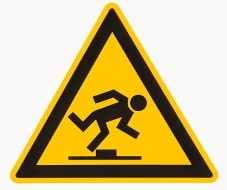Our client and her husband work as newspaper delivery people in Eugene, Oregon. One of their regular stops is a local bank, where they would deliver the newspaper at the drive-through teller’s window. One day, while making this stop, our client’s husband saw an old friend in the parking lot and parked the car to talk with his friend. She got out of the car to walk the newspaper to the teller’s window.  Walking up to the window, she caught her foot on a metal hook that was sticking out of the ground and fell face first onto the pavement.
Walking up to the window, she caught her foot on a metal hook that was sticking out of the ground and fell face first onto the pavement.
She sustained serious injury during the fall, including scrapes and bruising on her face and jaw, deep scrapes on both knees,
and a cervical strain. Almost immediately, her head started hurting, too. Her husband rushed her to a nearby urgent care, where the doctor diagnosed her with a concussion. The injury aggravated some pre-existing conditions, and she was soon suffering from dizziness and seizures that prevented her from working or driving.
She tried to file a claim with the bank’s insurance, but they denied it on the grounds that she was walking through an area not meant for pedestrians. Faced with mounting medical bills, lost wages, and a greatly diminished quality of life, our client called us for expert assistance in fighting her premises liability case.
I gathered evidence to support the client’s case. The area had not been signed warning pedestrians not to enter. Additionally, the metal hook that tripped our client was not painted a contrasting color or marked as a hazard in any way. It was detached from the rest of the wireless alert system it was part of, but no one from the bank – although it was clearly visible from the window – had fixed it or attempted to mark it as a possible slip and fall injury hazard. I approached the bank’s insurance carrier with this argument, and, faced with the facts, they agreed to accept liability.
Although this was definitely a step in the right direction, this case was far from over. I filed a demand letter and our client’s medical bills with the bank’s insurance carrier, but when the claim came back, the Oregon Health Plan had placed a huge lien on the claim which included unrelated medical treatment. I continued to fight for our client, disputing the lien. With her doctor’s assistance, we were able to separate the accident-related medical treatment from her other treatment. I was then able to negotiate a fair and reasonable settlement for reimbursement of the client’s medical bills – without the lien – and for the client’s pain and suffering.
Because this client called us, she was able to get the settlement she deserved from the insurance company – undoubtedly, she wouldn’t have been able to navigate the complex legal obstacles on her own. If you find yourself in a similar situation, needing the help of an experienced personal injury lawyer, call us. One of our expert Personal Injury Attorneys will be happy to discuss your Oregon Personal Injury case with you. Call us now: 541-617-0555

